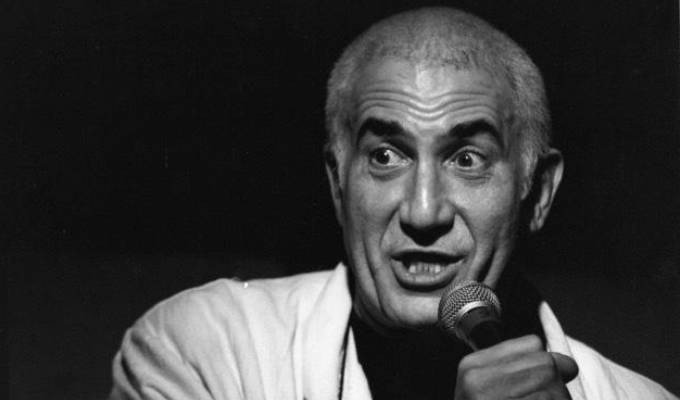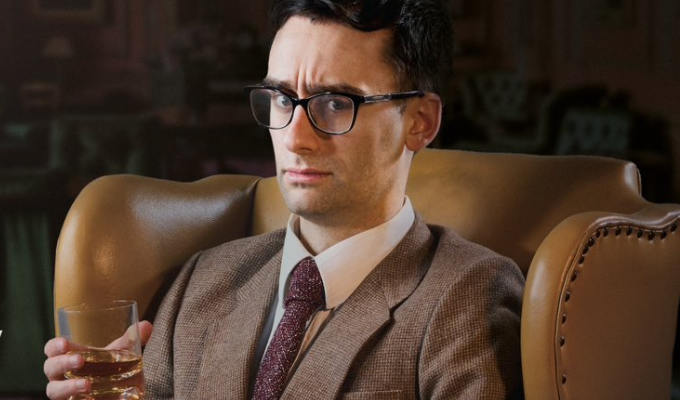
The Comedy Wars
Kim Wells on alternative versus old-style comedy
Kim Wells, compere and promoter of Earth Exchange Cabaret, one of the earliest alternative comedy venues, documents a heated dispute between Tony Allen, one of the founding fathers of alternative comedy, and old-style comedy script writer, Brad Ashton.
In early 1981, a year or so after I started compering and organising Earth Exchange Cabaret, I elected to do a comedy correspondence course with an old school professional comedy writer, Brad Ashton – a veteran who, over a career spanning more than 60 years, has written for a wide range of comedians, including Bruce Forsyth, Groucho Marx and Bob Monkhouse. It was quite well presented.
The first chapter covered how to write a gag by using such techniques as exaggeration, word play, puns and twisting clichés. He claimed gags could be ‘manufactured’ or ‘built’ and that professional comedy writers couldn’t always rely on inspiration so they needed techniques to help them do this.
One approach Ashton recommended was to write down words associated with the chosen subject. If this is the automobile, then words like ‘fan belt’, ‘battery’ and ‘traffic jam’ might spring to mind.
He gives examples of gags that it is possible to derive from these words using techniques like word play and punning. For ‘fan belt’, for instance, he cited a ‘word play’ gag: ‘Our star hasn’t arrived here yet because he’s had fan belt trouble. One of his fans belted him’. The example he gave for ‘battery’ is a pun: ‘I’ve paid cash for everything except the battery. I charged that.’ And for ‘traffic jam’, a ‘twisted cliché’: ‘If all the cars in the world were laid end to end ..... you'd get a Sunday afternoon.’
The second chapter was about how to string gags together to create a routine and how to personalise routines to make them fit the styles of individual comedians. Subsequent ones were on writing comic sketches, visual comedy and sit coms. Ashton later rejigged his correspondence course and published it under the title The Job of a Laughtime.
After sending in my first homework on the initial lesson on gag writing – gags about childhood – I was summoned to Ashton’s home on a Sunday afternoon. He said: ‘I thought I’d better get you in because you’ve written lots of pages but these contain very few gags.’ He had marked my script putting red ticks next to those few efforts he regarded as gags and numerous red crosses where my attempts had failed.
I remember Ashton patiently explaining to me that gags worked by ‘leading the audience up the garden path’ – by, for instance, appearing to refer to one context (eg car engine fan) and then unexpectedly switching to another context (celebrity fan). This might sound obvious but, judging by the number of red crosses I had earned, it wasn’t obvious to me at the time.
An ideological divide
The fact that Ashton called me in to give me extra free tuition showed that he cared – about comedy and his students. He confided in me about a heated argument he had with Tony Allen who had briefly been a student of his. It seems these two occupied opposite sides of an ideological divide. Tony was the idealistic standard bearer of comedy as the bearer of truth and meaning. He thought that formulaic joke-telling, at the time the dominant form in stand-up comedy, stood in the way of authenticity.

Tony was very much a ‘conviction comedian’, believing it important that stand-up comedians communicate ideas and experiences that mean something to them while also challenging and informing their audience. Otherwise he thought comedy ran the risk of seeming phoney and overly contrived as well as hollow, gutless and pappy.
Tony was also a political activist and social crusader who saw comedy as a vehicle to challenge conventional thinking and question the social order. For him, like quite a few of his left-leaning peers, ‘alternative’ had the added connotation of a form of comedy informed by an alternative, more liberated and egalitarian vision of society.
In contrast, Ashton was the self-styled realist championing comedy as lightweight, non-controversial entertainment, designed to appeal to a wide audience.
He maintained that ‘comedy writing is done by formula’. Writers use the same types of formula to generate gags, changing the characters, locales and wording to make them appear original material – a technique known as ‘switching’. His course was about teaching these formulae.
The Preston test
Tony, it seems, had vehemently rejected Ashton’s approach to comedy writing. Ashton, clearly taken aback (and hurt) by this, maintained Tony's type of comedy would only ever appeal to a few left-wing intellectuals and alternative types in North London and hippy havens like Portobello Road whereas to be successful comics would need to ‘appeal to the 19 million who lived in places like Preston’.
Though I found it depressing, I thought that Ashton was right about alternative comedy’s limited appeal. How wrong can you get? Mind you, in the course of its transition to the mainstream, ‘alternative’ comedy lost much of its political edge and intelligence as well as its quirkiness, experimental nature and authenticity.
Paradoxically alternative comedy owed much of its success to appealing to a demographic that was both different to - and more specific than – the nebulous ’19 million who lived in places like Preston’. Rather than the family, TV-watching audiences or the live working men’s club and seaside resort ones old-style comics tended to cater for, alternative comedy targeted a relatively young, increasingly college-educated audience, especially those in their twenties or thereabouts who were willing and able to go out in the evening.
Though Tony had the talent and stage presence to become a star, he never became mainstream (and famous) because he refused to compromise his artistic integrity and political beliefs.

Tony's temporary name change to protest against the sinking of The General Belgrano during Falklands’ War.
In 1984, Tony and I collaborated on a book about his approach to comedy. Tony brought me in to help him marshal and write down the cornucopia of ideas springing out of his ever creative, unruly brain. But we never got much down on paper. Instead we had some very exciting discussions about comedy, especially countercultural comedians like Lenny Bruce and George Carlin. We got as far as writing a fairly detailed synopsis but no further. Eventually, he did get it together to produce a great book, entitled Attitude.
Attitude
Tony’s approach to comedy differed from Brad Ashton’s in method as well as content. Tony’s approach was much more holistic: he thought that it wasn’t so much the gag itself that got the laugh but the ‘attitude’ of the one telling it. Becoming a competent comedian first and foremost involved finding one’s distinctive ‘attitude’. Tony talks about material being ‘informed by attitude’; it is attitude that ‘allows it to be owned’.
One example given by Tony is ‘Cheeky Chappie’ Max Miller, someone we talked about at length when we used to meet. He saw him live with his father at the Chiswick Empire when he was 12. The smutty humour was completely lost on him but he did clearly remember ‘the audience hanging on every word’ and a ‘pervading mood ... of something illicit happening, like at any moment we might be found out and asked to leave’.
He credits Miller with a comic attitude that was conspiratorial as well as cheeky. He cited the way he built up a mood of ‘furtive disclosure’ by sharing with the audience his anxiety that the theatre manager might be in the wings checking his material. Tony, the archetypical alternative comedian, had a sneaking respect for old-style, smutty comic Miller. He particularly admired him for the strong - ‘sparkling’ - rapport he was able to establish with audience.
Another example Tony cited at that time to illustrate how a successful attitude gets more laughter and can even make seemingly straight lines funny, was Norman Lovett: ‘The droll, new wave comic Norman Lovett shambles reluctantly to the microphone, looks at the audience as if contemplating hours of boredom, sighs and mutters world-wearily: "My name is Norman Lovett". Then raising his eyes as if lost for words and mildly exasperated, he says: "I get paid for doing this". On a good night he gets five laughs with this, two before he has even opened his mouth.’ (Extract from the book synopsis Tony and I produced in 1984)

Ashton’s and Tony’s approaches to writing and delivering comedy weren’t as radically different as Tony seemed to think. In the second chapter of his correspondence course which deals with personalising gags and routines to fit the differing styles of comedians, Ashton did acknowledge that attitude was important though he never used this word.
By personalising, he partly means adapting the material to fit the persona the comic is projecting – for instance, Woody Allen’s one as a self-deprecating neurotic non-entity, Rodney Dangerfield’s one as a loser and Jack Benny’s one as a tightwad. Personalising also meant exploiting a comedian’s unusual physical characteristics and other idiosyncrasies like Jimmy ‘Schnozzle’ Durante’s big nose: ‘With my nose, among the Eskimos I’m known as Casanova.’
Ashton talked about the importance of getting into the shoes of the comedian one is writing for and seeing the world from their perspective. Tony put more emphasis than Brad on attitude, seeing gags as secondary, whereas Brad saw both as important. But in this respect the difference between them was only one of emphasis.
Authenticity
The main reason Tony was dismissive of Ashton’s approach was that he thought it inauthentic. But a lot of the apparent disjunction between them can be put down to the fact that they were coming at comedy from different angles. Tony was writing material for himself whereas Brad was writing for other comics with the intention of pleasing them and their audiences.
Tony was therefore more inclined to focus on finding and embodying his attitudeand being authentic whereas Ashton, though it’s clear that he loved comedy and knew his craft, was a humble jobbing comedy writer trying to make a living. He was trying to make the material ‘authentic’ or sound authentic but for others, not himself.
I suspect that Tony never got to the chapter about personalising material and was put off by the first chapter that focused on gag writing. Many of the gags given as examples were dated, corny and sometimes politically incorrect – and, from Tony’s politically radical, countercultural perspective, totally devoid of any semblance of insightfulness, meaning or ‘street cred’.
If Ashton had been writing for Tony, I’m sure he would have tried to provide him with seemingly authentic and intelligen material, perhaps throwing in one or two gags about pot, squatting and police harassment. Although it may have been difficult for Ashton, a relatively conventional, middle-aged guy who lived in a suburban semi-detached house in affluent Southgate, North London, to slide easily into the shoes of Tony, a larger than life, dope-smoking, anarchistic hippie ex-squatter from the Portobello Road area with loads of attitude.
Bob’s your uncle: Monkhouse shows ‘em how
Recently I witnessed on TV a remarkable reconciliation between old-style and new wave comedy. In his final year of life (2003), Bob Monkhouse – one-time bête noire of alternative comics like Tony - performed a swan song set before an invited audience of fellow comedians, many of whom were younger, well-known alternative comics like Kevin Day and Josie Lawrence.
It was a truly masterful performance - described as a ‘masterclass in comedy’ - that evoked nothing less than awe and rapturous delight in the assembled throng of comedy connoisseurs. This was despite his set being sprinkled with old-style jokes about sex and ‘my wife’ – for instance: ‘I’ve never actually paid for sex ... I’ve left some screaming tarts behind me in a fury. I don’t understand prostitution. What man wants to go bed with someone who has nothing but total contempt for him and is only doing it for the money? You can get that at home.’
Speaking of taking his wife to a posh restaurant to celebrate their 29th wedding anniversary. he joked: 'I said to the head waiter, I’d like the crab toasted. He raised his glass to my wife and said "Your health."’
There was also a topical gag: ‘I see Monica Lewinsky is 31 today – it doesn’t seem long, does it, since she was crawling around on all fours in the Oval Office?’
Watching this performance, I realised Tony Allen’s insight about attitude was spot on: it wasn’t Monkhouse’s jokes so much that were funny, it was his attitude. The jokes were merely a pretext to trigger the laughs (or hooks to hang them on to) because he held you in a constant state of gleeful amusement and bemusement - and most of all one of suspense as to what would be his next verbal sleight of hand or the next garden path he’d lead you up.
He wasn’t endorsing the sentiments expressed in the gags. He told his gags at one remove, tongue-in-cheek. He knew some were a bit corny or over the line but he would say them anyway.
The joke was partly the joke itself – the fact it was naff, risqué or politically incorrect. Telling them was an act of bare-faced cheek – all the more so because he was performing to new wave, PC schooled comics. And as one comedian watching commented: for his audience that night, Monkhouse knew exactly where to draw the line between the risqué and the outright offensive - although at times he menacingly came very close to crossing it.
The Two Bennys: Hill and Elton
Alternative comics were perhaps too quick to dismiss old-style comedy. Its exponents were often masters of their craft and, despite their sometimes clichéd and politically suspect material, they could home in on the truth as determinedly as the most authentic of alternative comics.
Even Benny Hill, one of greats of British comedy, has been written off as old hat and sexist. He was vilified by Ben Elton in 1987 for contributing to the ‘worrying’ situation that ‘women can’t walk safe in the park anymore’. Elton was ridiculed remorselessly for this.
GQ magazine said in January 1987: ‘Pompous and portentous as this is, blaming Hill for rape statistics is like pointing a finger at concert pianists for causing elephant poaching.’ The Independent said it was ‘like watching an elderly uncle being kicked to death by young thugs’.
OK, Hill did overdo the role of an aging roué chasing scantily clad females. But he had so many more strings to his bow. His genius with words is evident in Fatricia And Feter: The Pinal Foem op Faul Pinch. This 1976 poem was supposedly written by Paul Finch (‘Faul Pinch’), a myopic poet, on an old-fashioned typewriter which had been repaired by an equally myopic repair man. He had mistakenly replaced the ‘p’ key with the ‘f’ key and vice versa.
It contained such wonderful lines as ‘pishing in the river’, ‘I peed myself with pood grown upon my parm’ and ‘They honeymooned in Niagara, she held him by the Palls’. He performed it impeccably, milking it for every possible laugh, even pausing mischievously when he read out the word ‘muck’. Schoolboy smut on the surface but the real joke is how much we are at the mercy of words.
Hill also wrote and performed wonderful songs like Ernie (The Fastest Milkman in the West) and insightful comic poetry like They Said It Couldn’t Be Done which parodied a famous motivational poem by Edgar A. Guest (and ended in the immortal lines: ‘But he faced up to what couldn’t be done, And he couldn’t bloody do it!’).
He was a truly multidimensional performer. And also a multinational, ubiquitous one – one of Britain’s foremost cultural exports. When I went to China in 1992, guess who was the first person I saw on TV. No prize for guessing what he was doing. The Chinese lapped it up.

In an about turn, Elton parodied himself as a politically correct spoilsport in Harry Enfield And Chums. The sketch ends with Elton being chased, to the sound of the Benny Hill theme tune, by women furious that Elton had tried to make them more feminist.
When I first saw the wonderfully irreverent Ben Elton at Earth Exchange in the early 1980s, I could never have foreseen that he would morph, even for an unguarded moment, into the self-righteous, straight-laced form of Mary Whitehouse. A blatant case of the ‘unity of opposites’ or, as a Taoist might put it, ‘the bigger the front, the bigger the back’.
Flanders and Swann: Intelligent comedy
The foundations for alternative comedy were laid down by previous generations of comics. These include the 1960s satirists like Peter Cook but also supposedly more conventional, ‘establishment’ comics like Flanders and Swann. This duo could have shown alternative comics a thing about being innovative and radical – and doing ‘intelligent’ comedy.
Comedy historian Graham McCann considers Flanders and Swann to be the most influential double act in British comedy even though they are now hardly ever talked about. They were ongoingly parodied on The Armstrong And Miller Show (which ran from 2007 to 2011) as posh, bumptious, overly jovial showbiz relics, singing risqué, mock-censored songs that were far bawdier than anything the urbane duo themselves contrived. The implication was they were archaic, reactionary and imminently ‘cancellable’.
‘The reality, however, is that neither Armstrong and Miller, nor just about anyone else involved in relatively intelligent comedy during the past 60 or so years, would have thrived anywhere near as well nor as widely without the achievements and lingering influence of Flanders and Swann,’ McCann wrote.
They sounded posh but they were relatively left-wing, went on CND marches and had a wide appeal stretching across the class divide. They were subtly subversive political satirists. In There’s A Hole In My Budget (1953), for instance, they sing about the problems faced by Chancellor of the Exchequer, Rab Butler, in balancing his budget: ‘Where will I get the money, dear Premier? ... from your budget, dear Butler, dear Butler.... But there’s a hole in my budget, dear Premier...".
And in the darkly comic Twenty Tons Of TNT, they highlight the fact that ‘the stock-piled mass destruction/Of the nuclear powers-that-be/Equals - for each man or woman - twenty tons of TNT’. In their gentle, indirect way, they confronted racism in their subtly ironic Song Of Patriotic Prejudice: ‘The English, the English, the English are best, So up with the English and down with the rest! It's not that they're wicked or naturally bad, It's knowing they're foreign that makes them so mad’.
Neil Clark in The Spectator also rates them highly, saying they ‘knew how to write a proper anti-war song’. He claims that though they were at their peak in the 1960s satire boom, ‘their more gentle brand of social commentary has aged considerably better than many of their more modern contemporaries who didn’t wear dinner jackets, bow-ties and boaters’.
For instance, one comic monologue written by Flanders, Built-Up Area. is about a prehistoric resident of Salisbury Plain complaining about a new development – Stonehenge. ‘Well, what is it anyway? A henge? Well, what's a henge? You may call it megalithic culture, I call it vandalism! I suppose you realise this is about the last nesting place for mammoths in the whole of Wessex? .... What is it then? It's a what? You're pulling my... a calendar? Well, it's a bit big for a calendar isn't it? I mean, you'd look a bit silly with that on your desk, wouldn't you?’
Given the new UK government is poised to cram whole housing estates into NIMBY’s backyards, this seems not only still relevant today but positively cutting edge.
A golden age?
Neil Clark sees Flanders and Swann as emblematic of a lost golden age of comedy, when jokes weren’t blue and the skies seemingly were. Clark laments the trend from the 1960s onwards towards more explicit, coarse, expletive-ridden comedy; and fondly harks back to the ‘richer’, ‘civilising’ post war era of ‘intelligent’ BBC dominated ‘light entertainment’ - before comedy ‘grew colder and nastier’ and far less ‘witty’.
Clark does over-glorify the heavily censored comedy of this period. This contained a lot of unintelligent dross and sexist and racist content – even the prim, ‘edifying’ BBC variety. He also understates the intelligence and wit of alternative comedy in its heyday and comedy since then – much of it ‘civilised’ and subtly witty like The Detectorists.
But he has a point. The relatively strict censorship regime faced by Flanders and Swann probably did to some extent, as Clark implies, have the benefit of obliging them and their contemporaries to be more innovative, imaginative, witty and, above all, subtle.
On the other hand alternative comics have had to face a different, sometimes equally restrictive censorship regime – one they initially imposed on themselves. Preceding generations of comics had used sexist and racist stereotypes to explore a wide range of emotionally charged areas of life like sex, marriage, gender, ethnic identity and religious allegiance. Alternative comics have had to either to avoid mining these extensive, rich veins of humour or face up to the daunting challenge of exploring them without trading off these stereotypes or appearing in any way to give them credence.
This problem has been compounded by having had to face an increasingly PC-aware audience, sometimes intent on policing their material for signs – real or imagined - of sexist and racist attitudes.
Uniquely alternative or just another revolution in comedy?
Despite the hype, 'alternative' comedy was arguably no more alternative than other revolutions or creative innovations in comedy like The Goons, Beyond The Fringe and Monty Python. Nor was alternative comedy unique in its quest to be authentic, meaningful and radical. In several ways, it can be seen as a reconnection with the intelligent, anti-establishment comedy of the satirical 1960s.
The more quirky and anarchist types of alternative comedy - more evident in its early days – could also be viewed as a continuation of the surrealist strand in comedy made popular in the 1950s by the Goons and in the 1960s and 1970s by Monty Python and comic jazz bands like Bonzo Dog. A quirky, surreal component was also contributed by some of the many street performance artists who found their way on to the alterntive comedy/cabaret circuit like Randolph The Remarkable and Hubert and Hilary Haddock’s Fire and Fish Fantasy.

One distinctive feature of alternative comedy was that it did explicitly challenge the pervasive sexist and racist stereotypes of the era. Comedy has done this to varying degrees through the centuries (pantomime dames, cross-dressing etc), but ‘alternative comedy’ formally made a point of consistently doing so. Some comics even turned it into a crusade.
Alternative comedy’s most distinctive feature – and greatest achievement - is doing something that preceding revolutions in comedy like the Goons, 1960s satirists and Monty Python (which were exclusively or mostly radio and TV-propagated) failed to do. It reversed the trend away from live entertainment which, apart from pop music and the brief folk revival of the 1960s, had been on the decline for several decades.
It did this by appealing to a younger, mainly twenties-something audience who were prepared (and free) to go out rather than stay fixed to the TV screens. This was achieved through a remarkable symbiosis between live alternative comedy and television which up to this point had been responsible for systematically decimating live entertainment. In the ultimate irony, alternative comedy was propelled to national prominence by TV programmes like Saturday Live. This led to the proliferation of live comedy venues all over the country, including Ashton’s proverbial Preston.
Comedy rapidly becomes dated, clichéd and stale - and in need of the breath of fresh air. Alternative comedy was basically one of a succession of innovative movements that rejuvenated the aging, old-style forms of comedy that preceded them and rejigged and repackaged these to match the values and preoccupations of a new era and a new generation of potential comedy consumers.
The new music hall?
In the early 1980s, Tony Allen predicted that alternative comedy would become the new rock’n’roll. In some ways, it did. But a closer parallel is with the development of the music hall in the 19th century. Both alternative comedy and music hall made live entertainment much more widely available.
Both started in small venues, mostly public houses. In its early days, alternative comedy was usually staged as part of a cabaret-style package that included a large component of variety acts, matching the diversity of music hall. Alternative comedy itself was diverse. As well as stand-up, it featured a wide range of comedy formats including clowning, double acts, sketch-based ensembles and music-based comedy.
Magicians and jugglers also incorporated a lot of comedy into their acts. Some of this comedy could even be described as alternative in aspiring to be non-sexist and non-racist, ‘right-on’ or left-wing. For instance, conjuror Ian Keable promised ‘magic with socialism’. Magician Jerry Sadowitz could also be described as essentially alternative despite making a point of being politically incorrect. Given his contrarian tendency to take alternative comedy one step further by ‘shaking up the right-on values of the 1980s’, as The Guardian put it, he could even be described as ‘alternatively alternative’.
Even less politically correct, old-school performers who strayed on to the alternative circuit usually learned to ‘correct’ their attitudes and talk the PC talk. Although there were some less evolved, insufficiently house-trained ones who had the odd relapse and trespassed into taboo territory – like one Earth Exchange comic who, when accused of being sexist by a gay guy, retaliated by calling him a ‘fucking p.....’. This provoked the outraged gay to throw a flower pot at him, an unheard-of occurrence at Earth Exchange, known for its supremely civilised ambience.

When I started, Earth Exchange Cabaret in early 1980, my vision was to resurrect live music hall, variety-based entertainment. Other pioneering venues like Jongleurs also featured diverse bills although The Comedy Store tended to specialise in stand-up (adding improv in 1985). Jongleurs’ promoter, Maria Keminska, made it her mission to promote variety-based bills and CAST described the shows it presented in a number of venues as ‘New Variety’. This mix of alternative comedy and variety acts was more commonly referred to as ‘alternative cabaret’.
However, as the 1980s progressed, live alternative comedy/cabaret became less and less diverse as stand-up increasingly squeezed out other forms of comedy and variety acts. Consequently the parallel with music hall though still evident became less apparent. But, to my mind, the cabaret-style mix of entertainment of which alternative comedy was an inseparable part in the 1980s (particularly the early and mid-1980s) is more appropriately seen as new music hall rather than something uniquely ‘alternative’.
• Read Kim Wells’ four-part series on the Earth Exchange, here
Published: 4 Sep 2024






